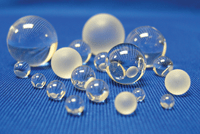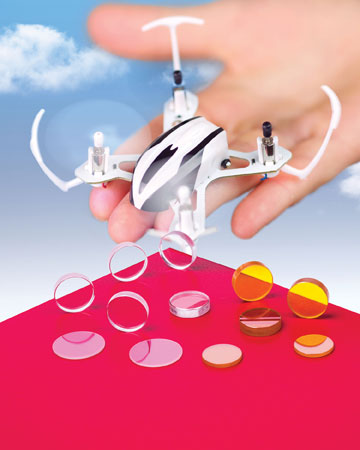|
Thursday, September 22, 2016 |
|

|
|
|

|
| sponsor |
 |
|
Machine Vision Helps Adhesive Trend Stick in Auto Industry
Business has been getting stickier for Ron Weber, president of USS Vision, a Livonia, Mich., machine vision integration and automated inspection system firm. As automakers race to meet federal regulations that call for higher fuel-efficiency standards — 54.5 miles per gallon by 2025 — his firm is seeing more vehicles with body parts joined with adhesives. In recent years, that trend has translated into 11 percent annual increases in the adhesive bead inspection business offered by USS Vision, whose customers include GM, Ford Motor, Chrysler and Toyota.
|
|
|
|
|
|
More Underrepresented Students Pursue STEM Due to Research Mentoring
A recent study indicates that undergraduates in minority-serving institutions who participate in mentored research not only graduate more often with science degrees, but also attend graduate school and pursue STEM careers at higher rates. Although undergraduate STEM research is standard at many major research universities, public minority- and Hispanic-serving institutions have historically struggled to provide their students with equivalent experiences.
|
|
|
|
|
|
Scientists Discern Light-Driven Molecular Changes Using LCLS Laser
To better understand how molecules undergo light-driven chemical transformations, a research team from the Argonne National Laboratory, Northwestern University, the University of Washington and the Technical University of Denmark used the Linac Coherent Light Source (LCLS) at the Department of Energy’s SLAC National Accelerator Laboratory to image molecules in their excited state.
|
|
|
|
|
|
Laser Treatment Boosts Conductivity in Printed Graphene
Treating inkjet-printed, multilayer graphene electric circuits and electrodes with a pulsed-laser process improves electrical conductivity of the graphene without damaging paper, polymers or other fragile printing surfaces. The discovery of this technology could lead to low-cost applications for printed graphene electronics.
|
|
|
|
|
|
NIR Light Upregulates CCO, Stimulates Blood Flow
Broadband NIRS has potential as a noninvasive, in vivo means to study mechanisms of photobiomodulation and perform treatment evaluations of low-level laser/light therapy (LLLT). In a placebo-controlled study, researchers at the University of Texas at Arlington used broadband NIRS to assess the cytochrome-c-oxydase (CCO) enzyme upregulation effects of photobiomodulation in human tissues in vivo, by measuring the LLLT-induced changes in CCO and hemoglobin (Hb) concentrations in human forearms in vivo.
|
|
|
|
|
|
 Ball and Spherical Lenses
Ball and Spherical Lenses
Applied Image Inc.
APPLIED IMAGE manufactures optically pure BALL (spherical) Lenses in custom diameter sizes using a wide variety of materials, including Infrared Chalcogenide composite IRG26. They can be used as a single optical element or spherical lens; function as a basis for comparison; or be re-shaped (re-formed).
Visit Website
Request Info
|
|
|
|
|
 Unmanned Vehicle Optics
Unmanned Vehicle Optics
Meller Optics Inc.
Custom fabricated sapphire, germanium, ZnS, silicon and zinc selenide optics for use in gimbaled systems and front surface protection in unmanned air- and undersea vehicles are available from Meller Optics, Inc. of Providence, Rhode Island.
Visit Website
Request Info
|
|
|
|
|
Micro Photonics 2016
October 11-13, 2016 - Berlin ExpoCenter City - Berlin Germany
Micro Photonics 2016 is a unique platform for the development, production and application of miniaturized optical components. The trade fair and the extensive conference program will offer many opportunities to meet potential customers and partners in the growth markets of micro/nanophotonics and biophotonics. The congress will cover the latest trends in micro/nanophotonics and biophotonics with a balance of scientific and industry presentations.
|
|
|
|
Laser Measurement Best Practices: How to Avoid Choosing the Wrong Power/Energy Sensor
Tue, Sep 27, 2016 1:00P EDT
Sensors are critical for accurate laser measurement, yet they are often selected based on the wrong criteria. In this webinar, Ophir-Spiricon sales engineer Dick Rieley will discuss laser measurement best practices and will guide you through key factors in the sensor selection process, including beam diameter, beam density values, cooling requirements, and exposure duration. Choosing the wrong laser sensor can result in a damaged sensor and invalid measurements of the laser’s performance. Join us for this free webinar on sensor selection, to be sure that you make the right choice.
|
|
|
|
 |
|
|
|

CALL FOR ARTICLES!
Photonics Media is currently seeking technical feature articles on a variety of topics for publication in our magazines (Photonics Spectra, Industrial Photonics, BioPhotonics and EuroPhotonics). Please submit an informal 100-word abstract to Managing Editor Michael Wheeler at Michael.Wheeler@Photonics.com, or use our online submission form.
|
|
|
|
 |
|